|
| ID |
Image |
Oil Pantings, Sorted from A to Z |
Other Information |
| 76746 |
 |
Selbstmord der Lukretia |
Date 1518(1518)
Medium Oil on linden
Dimensions 168 ?? 74,8 cm
cyf |
| 42216 |
 |
Sele-Portrait with Bandage |
mk168
204x208cm
|
| 42222 |
 |
Sele-portrait with Landscape |
mk168
52x41cm
|
| 1032 |
 |
Self Portrait in a Fur Coat |
1500
Pinakothek, Munich |
| 97481 |
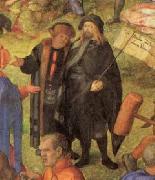 |
Self portrait of Albrecht Durer |
1508(1508)
Medium oil on panel transferred on canvas
Dimensions 99 X 87 cm
cyf |
| 1031 |
 |
Self Portrait with Gloves |
1498
Museo del Prado, Madrid |
| 55982 |
 |
self portrait with gloves |
mk247
1498,oil on panel,20x16 in,52x41 cm,museo del prado,madrid,spain |
| 1030 |
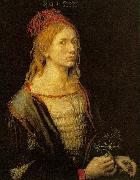 |
Self Portrait _8 |
1493
Musee du Louvre, Paris |
| 26718 |
 |
Self-Portrait |
mk52
1500
Oil on wood
67x49cm
Alte Pinakothek,Munich
|
| 28510 |
 |
Self-Portrait |
mk61
1498
|
| 28729 |
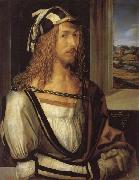 |
Self-Portrait |
mk61
1498
Oil on panel
52x41cm
|
| 33508 |
 |
Self-Portrait |
mk86
1498
Oil on wood
52x41cm
Oil on wood
52x41cm
Madrid,Museo del Prado
|
| 42214 |
 |
Self-Portrait |
mk167
276x202mm
New York
|
| 44875 |
 |
Self-portrait |
mk176
1500
Oil on panel
26x19
|
| 21354 |
 |
Self-portrait (mk08) |
1498
Oil on wood 52x41cm
Madrid,Museo del Prado |
| 21821 |
 |
Self-Portrait (mk10) |
1493,Oil on parchment Mounted on canvas
56 x 44 cm
Paris,Musee du Louvre |
| 25911 |
 |
Self-Portrait (mk45) |
1498
Oil on panel
52x41cm
Madrid,Museo Nacional del Prado
|
| 25967 |
 |
Self-Portrait (mk45) |
1493
Parchment on panel
56.5x44.5cm
Paris,Musee du Louvre
|
| 42209 |
 |
Self-portrait as a Boy |
mk168
275x196cm
Vienna
|
| 63635 |
 |
Self-Portrait as the Man of Sorrows |
1522 Drawing with lead pencil on blue-green primed paper, 408 x 290 mm Kunsthalle, Bremen The drawing was destroyed in war. The Man of Sorrows is generally considered to be a self-portrait of D?rer created during his journey to the Netherlands. Semi-naked with a sunken chest and lips parted in pain, the man is gazing very naturalistically out of the picture. His crossed arms and the Instruments of the Passion such as the scourge and fasces remind us of Christ's sufferings.Artist:D?RER, Albrecht Title: Self-Portrait as the Man of Sorrows Painted in 1501-1550 , German - - graphics : portrait |
| 63644 |
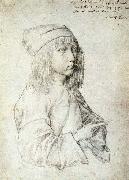 |
Self-Portrait at 13 |
1484 Silverpoint on paper, 275 x 196 mm Graphische Sammlung Albertina, Vienna At the age of 13, D?rer created the earliest self-portrait of an artist at so young an age. Using silverpoint, the features of D?rer with which we are familiar from later self-portraits, though still rather childlike here, are depicted with gentle strokes. Like one of Martin Schongauer's Late Gothic angels in depictions of the Annunciation, the boy is also pointing to the right. His left hand is concealed beneath his sleeve, thus suggesting that this self-portrait was painted in front of a mirror.Artist:D?RER, Albrecht Title: Self-Portrait at 13 Painted in 1501-1550 , German - - graphics : portrait |
| 63728 |
 |
Self-portrait at 22 |
1493 Oil on linen, transferred from vellum, 57 x 45 cm Mus?e du Louvre, Paris This is D?rer's first painted self portrait, dated 1493. It is the earliest known self portrait in European art produced as an independent painting (although earlier artists had sometimes portrayed themselves among figures in an altarpiece or fresco). A sketched self portrait, dated 1493 on the reverse, could well have been an early study for the oil painting. D?rer completed the oil painting towards the end of his travels as a journeyman, almost certainly in Strasbourg. It was originally on vellum, which would have made it relatively simple to transport, and this suggests that it might well have been sent back to Nuremberg. D?rer inscribed at the top of the self portrait: `Things with me fare as ordained from above', a sign of his faith in God. The artist's youthful features are framed by his lanky, ginger hair, which is topped by a red tasselled cap. Beneath his grey cloak, fringed with red, he wears an elegant pleated shirt with pink ribbons. His strong nose, heart-shaped upper lip and long neck are emphasized in the painting. Using a mirror, D?rer obviously found it difficult to paint his hands and eyes, the two features which are always a challenge in a self portrait. In his rough hands, D?rer holds a sprig of sea holly, a thistle-like plant. Its German name means `man's fidelity' and this, together with the fact that the plant was sometimes regarded as an aphrodisiac, has led to speculation that the self portrait was intended as a gift for his fianc?e. While D?rer was away, his father had arranged for Agnes Frey to become his wife and they eventually married on 7 July 1494, two months after his return to Nuremberg. However, it is just as likely that the self portrait was a gift for his parents, whom he had not seen for nearly four years. One can imagine the surprise and pleasure they must have felt to receive this picture after their son's long absence. It would have been a reminder of his handsome features and further evidence of his blossoming talent.Artist:D?RER, Albrecht Title: Self-portrait at 22 Painted in 1501-1550 , German - - painting : portrait |
| 89380 |
 |
self-portrait at 22 |
1493(1493)
Medium Oil on linen, transferred from vellum
cyf |
| 63730 |
 |
Self-Portrait at 26 |
1498 Oil on panel, 52 x 41 cm Museo del Prado, Madrid This self portrait is dated 1498 and inscribed: `I have thus painted myself. I was 26 years old. Albrecht D?rer.' Since the artist turned 27 on the 21 May, the picture must date from the beginning of the year. The artist's pose is self confident, showing him standing upright and turning slightly to lean his right arm on a ledge. D?rer's figure fills the picture, with his hat almost touching the top. His face and neck glow from the light streaming into the room and his long curly hair is painstakingly depicted. Unlike his earlier self portrait, he now has a proper beard, which was then unusual among young men. Nine years later D?rer wrote an ironic poem in which he described himself as `the painter with the hairy beard'. The artist's clothing is flamboyant. His elegant jacket is edged with black and beneath this he wears a white, pleated shirt, embroidered along the neckline. His jaunty hat is striped, to match the jacket. Over his left shoulder hangs a light-brown cloak, tied around his neck with a twisted cord. He wears fine kid gloves. Inside the room is a tall archway, partly framing D?rer's head, and to the right a window opens out onto an exquisite landscape. Green fields give way to a tree-ringed lake and beyond are snow-capped mountains, probably a reminder of D?rer's journey over the Alps three years earlier. Depicting a distant landscape, viewed through a window, was a device borrowed from Netherlandish portraiture. The Germans still tended to consider the artist as a craftsman, as had been the conventional view during the Middle Ages. This was bitterly unacceptable to D?rer, whose second Self-Portrait (out of three) shows him as slender and aristocratic, a haughty and foppish youth, ringletted and impassive. His stylish and expensive costume indicates, like the dramatic mountain view through the window (implying wider horizons), that he considers himself no mere limited provincial. What D?rer insists on above all else is his dignity, and this was a quality that he allowed to others too. This picture was acquired by Charles I of England and later bought by Philip IV of Spain.Artist:D?RER, Albrecht Title: Self-Portrait at 26 Painted in 1501-1550 , German - - painting : portrait |
| 63738 |
 |
Self-Portrait in a Fur-Collared Robe |
1500 Oil on lime panel, 67,1 x 48,7 cm Alte Pinakothek, Munich The last of D?rer's three magnificent self-portraits was painted early in 1500, before his 29th birthday on 21 May. The picture is proudly inscribed: `Thus I, Albrecht D?rer from Nuremburg, painted myself with indelible colours at the age of 28 years.' It is a sombre image, painted primarily in browns, set against a plain dark background. The face is striking for its resemblance to the head of Christ. In late medieval art, Jesus was traditionally presented in this manner, looking straight ahead in a symmetrical pose. Christ's brown hair in these images is parted towards the middle and falls over the shoulders. For the first and last time in Western art history, an artist was to portray himself in a Christ-like scheme. Given his idealized appearance as the underdrawing shows, his nose was originally irregular in shape - D?rer is approaching us in "imitatio Christi", in imitation of Christ. He has a short beard and moustache. D?rer has even painted himself with brown hair, although the other self-portraits show that it was actually reddish-blond. D?rer deliberately set out to create a Christ-like image, with his hand raised to his chest almost in a pose of blessing. But this was no gesture of arrogance or blasphemy. It was a statement of faith: Christ was the son of God and God had created Man. For D?rer, the painting was an acknowledgment that artistic skills were a God-given talent. However, D?rer has subtly departed from the traditional image of Christ in his self-portrait. Despite initial appearances, the picture is not quite symmetrical. The head lies just off the centre of the panel to the right and the parting of the hair is not exactly in the middle, with the strands of hair falling a little differently on the two sides. The eyes stare slightly towards the left of the panel. D?rer also wears contemporary clothing, a fashionable fur-lined mantle. The result is a highly personal image, one whose `indelible colours' still influence the way we imagine D?rer looked in his later years. The deceptive illusionism in which the picture is painted is also, however, a reference to the classical artistic legend about Apelles, with whom he had been compared by contemporary humanists.Artist:D?RER, Albrecht Title: Self-Portrait in a Fur-Collared Robe Painted in 1501-1550 , German - - painting : portrait |
| 92004 |
 |
self-portrait in a Fur-Collared Robe |
1500(1500)
Medium oil on linden
cyf |
| 42220 |
 |
Self-portrait in the nude |
mk168
pen and brush
291x153mm
|
| 42210 |
 |
Self-Portrait of Durer-s Father |
mk168
284x212mm
|
| 63647 |
 |
Self-Portrait with a Bandage |
1491-92 Pen drawing on paper, back side, 204 x 208 mm Graphische Sammlung der Universit?tsbibliothek, Erlangen D?rer's self portrait with a bandage presumably dates from the first period of his journeys; it was sketched with rapid strokes, and D?rer's face with his inquiring gaze stands out. The hand gesture is reminiscent of the tradition of depictions of Christ suffering, of melancholy and sleep. An interpretation of melancholy fits in most readily with a self portrait in this manner.Artist:D?RER, Albrecht Title: Self-Portrait with a Bandage Painted in 1501-1550 , German - - graphics : portrait |
| 30450 |
 |
Self-Portrait with Fur Coat |
mk68
Oil on limewood
26 1/2"x19 1/2"
Munich
Alte Pinakothek
1500,Germany
|
| 23285 |
 |
Self-Portrait with Gloves (nn03) |
1498
Oil on panel 52 x 41 cm 20 1/2 x 16 1/8 in Museo del Prado Madrid |
| 26717 |
 |
Self-Portrait with Landscape |
mk52
1498
Oil on wood
52x41cm
Prado,Madrid
|
| 42219 |
 |
Self-Portrait with sea holly |
mk168
56.5x44.5cm
Paris
|
| 40279 |
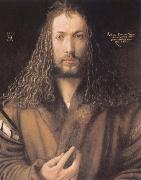 |
Self-protrait in a Fur-Collared Robe |
mk156
1500
Oil on limewood panel
67.1x48.9cm
|
| 63657 |
 |
Side, Front, and Back View of a Helmet |
1503 Pen, 422 x 268 mm Mus?e du Louvre, Paris The date 1514 is false. D?rer apparently owned the helmet. The side view was used in the 1503 copperplate engraving "The Coat-of-arms of Death," the front view in the engraving (to be dated not much later) "Coat-of-arms with a Rooster."Artist:D?RER, Albrecht Title: Side, Front, and Back View of a Helmet Painted in 1501-1550 , German - - graphics : study |
| 63684 |
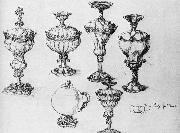 |
Six Goblets - Pen |
200 x 285 mm Bibliothek, Dresden The legend reads: "morgen will ich ir mer machn" (tomorrow I shall make more of them). Individual Italian motifs are mingled with the German late Gothic style.Artist:D?RER, Albrecht Title: Six Goblets Painted in 1501-1550 , German - - graphics : other |
| 42213 |
 |
Six Pillows |
mk167
Pen and ink on paper
276x202mm
|
| 53757 |
 |
Sjalvportratt |
mk234
1498
40x52cm |
| 56574 |
 |
sjalvportratt |
mk248 kompositionen av detta portratt pa panna foljer den florentinska stilen.klader,frisyr ocb utsikten mot de snotackta bergen i fjarran ar indikationer pa att durer betraktade sig sjalu som en adel varldsman, ingen vanlig provinsiell bantverlare. |
| 42349 |
 |
Sketch Sheet with the Rape of Europa |
mk168
290x415mm
|
| 52026 |
 |
St Anne with the Virgin and Child |
1519
Oil and tempera on canvas |
| 63609 |
 |
St Anthony |
96 x 143 mm Metropolitan Museum of Art, New York D?rer recorded in his diary of the trip to the Low Countries, 1520/21, that he gave away St Anthony as a present on six occasions. It is one of the very few D?rer engravings in horizontal format. St Anthony (ca. 250-350 A.D.) was the first Christian monk. He lived in Egypt and loved poverty, piety and scholarship. The traditional rendering of this saint shows him in the desert beset by fantastic creatures, a scene which allows the freest reign to an artist's imagination. But D?rer chose to picture him in a melancholy mood, in a setting where the scenery dominates the composition. The background is a cityscape taken over from an entirely different subject, the drawing Pupila Augusta which D?rer had laid aside many years before. The composition is almost cubistic in concept. The contours of saint and scene correspond. During this year D?rer experimented with "cubistic" figures and faceted faces, which like St Anthony seem to have been put together block by block.Artist:D?RER, Albrecht Title: St Anthony Painted in 1501-1550 , German - - graphics : religious |
| 63611 |
 |
St Apollonia |
1521 Chalk drawing on green primed paper, 414 x 288 mm Staatliche Museen, Berlin The chalk drawing was an individual study for a planned monumental Madonna with saints, of which six preliminary drawings exist. The figure of St Apollonia appears on two of these studies. The drawing depicts a moment of spiritualization: St Apollonia is portrayed as a young woman who appears to be imbued with inner concentration. She is portrayed in so individual a style that it is still disputed whether D?rer used a model or created an ideal figure from his imagination.Artist:D?RER, Albrecht Title: St Apollonia Painted in 1501-1550 , German - - graphics : study |
| 63619 |
 |
St Bartholomew |
1523 Engraving, 122 x 76 mm Metropolitan Museum of Art, New York The knife in the hand of the saint is the instrument of his martyrdom. The engravings of the Apostles of this last period are quite subdued and unemotional. The stance requires the viewer to look at the head of the saint and to seek out what characterizes his greatness. The absence of a halo, which distinguishes this plate and St Simon from the earlier members of the set of Apostles, can be pointed out. St Bartholomew is more down-to-earth than the lofty type of 1514. These men are more modest, like artisans; their bodies disappear beneath the draperies. They fill the picture area from top to bottom and have a metallic quality, almost like bronze statues. The preparatory drawing is, in this case, much larger than the print.Artist:D?RER, Albrecht Title: St Bartholomew Painted in 1501-1550 , German - - graphics : religious |
| 63617 |
 |
St Christopher Facing to the Left |
1521 Engraving, 119 x 75 mm Metropolitan Museum of Art, New York This engraving is obviously the later of the two versions of 1521. The meaning is here conveyed more poignantly, as the saint, instead of looking straight ahead, turns his head toward the Infant Christ. The hermit, in this case, is moved further into the background. This engraving is probably also based on the drawings prepared for Joachim Patenier. It can be noted in this connection that Patenier's painting at the Escorial shows a quite similar group, only in mirror image. Both engravings are based on the account of St Christopher in Passional oder der Heiligen Leben, Nuremberg, 1488, published by Anton Koberger, D?rer's godfather.Artist:D?RER, Albrecht Title: St Christopher Facing to the Left Painted in 1501-1550 , German - - graphics : religious |
| 63616 |
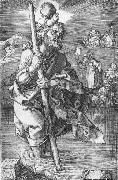 |
St Christopher Facing to the Right |
1521 Engraving, 117 x 75 mm Metropolitan Museum of Art, New York This is the first engraving after D?rer's return from his long stay in the Netherlands. He had left on July 12, 1520, together with his wife and a maid, in order to appeal to the new Emperor, Charles V, to confirm his annuity. No engravings were executed during this trip. D?rer returned to Nuremberg toward the end of July 1521, having been greatly honoured, yet also a sick man suffering from malaria. This engraving is presumably based on one of the several drawings D?rer made at Antwerp for the Dutch landscape painter Joachim Patenier in May 1521. The hermit in the background is carrying a torch.Artist:D?RER, Albrecht Title: St Christopher Facing to the Right Painted in 1501-1550 , German - - graphics : religious |
| 63579 |
 |
St Eustace |
1501 Engraving, 355 x 259 mm Fogg Art Museum, Cambridge The print is often erroneously called "St Hubert." This is D?rer's largest single-leaf copper engraving. He frequently sold impressions of it or gave them away as presents during his journey to the Netherlands. The legend of St Eustace is narrated in the Legenda aurea and is freely adapted in D?rer's picture. The Roman officer Placidus was converted to Christianity by a vision of a stag who spoke with the voice of Christ and carried a crucifix in its antlers, and he then took the name of Eustace. Here, the scene is taking place in the middle of a forest landscape, next to a pond. The statue-like depiction of the horse and the greyhounds, which are shown in five different body positions, shows that D?rer was more interested in reproducing proportions than in creating a precisely detailed account of the Christian legend. D?rer carefully avoided any overlapping of the animals. In this end and other details this print is closely related to Pisanello's painting of the same subject (National Gallery, London). The unusually large size of the plate appears to have caused some difficulty in printing. Even some of the best impressions have some squeezed lines near the edges. There are impressions on satin, all posthumous, at Coburg, Boston, Vienna, Gotha and Frankfurt.Artist:D?RER, Albrecht Title: St Eustace Painted in 1501-1550 , German - - graphics : religious |
| 63589 |
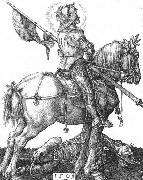 |
St George on Horseback |
1505 (completed 1508) Engraving, 110 x 86 mm Metropolitan Museum of Art, New York The last work before D?rer's sudden departure on a second trip to Venice in order to escape the Great Plague. This engraving was probably almost complete because the date 1505 had already been engraved in the plate. It was subsequently corrected to read 1508. The background is deliberately reduced in scale for sake of contrast and any indication of a landscape is omitted. D?rer in this engraving sought to combine the monumentality of The Large Horse with the elegance of The Small Horse. Pictured from behind, this unusual stance effectively conveys a feeling of pause before the saintly warrior forges ahead to further defend the Faith. It was also used in the Ober St. Veit Altarpiece, which was completed in D?rer's workshop during his absence in Italy.Artist:D?RER, Albrecht Title: St George on Horseback Painted in 1501-1550 , German - - graphics : religious |
| 63602 |
 |
St Jerome in his Study |
1514 Engraving, 259 x 201 mm Staatliche Kunsthalle, Karlsruhe St Jerome in his Study is stressing the contemplative rather than the active aspect of Christian life. The engraving shows the translator of the Bible deep in thought at his lectern, with the figure of the saint illuminated by sunlight streaming through the window panes into the cosy room. In front of St Jerome are the resting figures of his faithful lion and dog. A skull on the windowsill and an hourglass above the saint are reminders of the transience of life. The astonishing advance in D?rer's printmaking technique is evident when this engraving is compared with his early woodcut of the same subject. D?rer, according to the diary of his trip to the Netherlands during 1521-21, sold or gave away copies of this print more frequently than any of his others. It has been repeatedly asserted that this engraving was to be part of a projected series representing the four human temperaments. Only two others have been so far identified, Melencolia I, and Knight, Death and Devil. Although they correspond in size, D?rer never gave away all three as a set. Occasionally he gave away St Jerome and Melencolia I as a pair. In the last of the three master engravings, D?rer placed particular emphasis on the subtle differentiation of the material qualities of the objects, and the depiction of the interior according to the laws of central perspective, the converging lines of which terminate in the space to the right of the figure of the saint. The design is based on an exact plan of perspective. A certain degree of distortion is due to the fact that the vanishing point is placed close to the margin instead of the centre. This is a peculiarity that can be observed in other works by D?rer.Artist:D?RER, Albrecht Title: St Jerome in his Study Painted in 1501-1550 , German - - graphics : religious |
| 63642 |
 |
St Jerome in His Study |
1511 Pen, 190 x 151 mm Biblioteca Ambrosiana, Milan Preliminary study for the woodcut, in which the composition is further simplified and compressed, a large white curtain of diagonal contour playing a decisive role in the change.Artist:D?RER, Albrecht Title: St Jerome in His Study Painted in 1501-1550 , German - - graphics : study |
| 63731 |
 |
St Jerome in the Wilderness |
1495 Oil on panel, 23 x 17 cm National Gallery, London St Jerome kneels as a penitent. In his right hand he holds the Bible, which he translated into Latin, and in his left hand the stone which he is using to beat his breast. His eyes stare upwards, beyond the small crucifix stuck into the tree trunk. Wearing a blue gown, his red mantle and cardinal's hat lie beside him on the ground. Behind is his faithful lion, befriended after he had removed a thorn from its paw. In the background is a landscape with dramatic rock formations, probably based on sketches that D?rer had made of the quarries near Nuremberg. The scene is lit by a dramatic evening sky. The reverse of the panel depicts an apocalyptic celestial phenomenon, a red star-like light and a streaking golden disc. Although some scholars have considered it to be an eclipse or meteor, it is almost certainly a comet. D?rer's image is probably derived from woodcuts of comets published in the Nuremberg Chronicle of 1493. A similar object to the one painted by D?rer appears in the sky of his engraving of Melencolia I, made 20 years later. This small panel was only recognized as a D?rer in 1956. Art historian David Carritt realized that the lion is similar to that in a gouache which D?rer painted in Venice in 1494.Artist:D?RER, Albrecht Title: St Jerome in the Wilderness Painted in 1501-1550 , German - - painting : religious |
| 63567 |
 |
St Jerome Penitent in the Wilderness |
1496 Engraving, 324 x 228 mm Metropolitan Museum of Art, New York The stone in the saint's right hand serves to strike his chest. In this engraving too Italian influence is manifest. The scenery in the background, however, is based on sketches of quarries in the vicinity of Nuremberg). There is a certain lack of cohesion between the various parts of this unusually large plate. St Jerome, one of the most learned Fathers of the Church and author of the Vulgate, was born in 331 or 342 in Dalmatia of a well-to-do family. He died in 420. He was one of the favourite saints of D?rer's time, but, curiously, Martin Luther was less than fond of him. "I know of no one among the teachers whom I bear as much enmity as St Jerome, for he speaks only of fasting, virginity, etc."Artist:D?RER, Albrecht Title: St Jerome Penitent in the Wilderness Painted in 1501-1550 , German - - graphics : religious |
| 63572 |
 |
St John's Church |
1489 Watercolour and gouache on paper, 29 x 42 cm The Hermitage, St. Petersburg This watercolour is among the earliest landscape paintings in European art to depict a specific location. D?rer may well have painted it in the summer of 1489, at the age of 18, although it could date from 1494 after his journeyman travels. Inscribed `Saint John's Church', it shows the church and a row of houses which lay just to the west of Nuremberg. Nearly 40 years later D?rer was to be buried in Saint John's graveyard. D?rer's watercolour view faces south, with a view of the distant hills beyond. The perspective is curious; it is almost a bird's-eye view. The row of houses appears flat rather than three-dimensional. Despite these problems, D?rer has lavished great care on the picture. In his early watercolours he was more concerned about the rendering of detail, rather than the overall effect. The watercolour of Saint John's Church was looted during the Second World War and lost for nearly 50 years. Owned by the Kunsthalle in Bremen, it was among thousands of Old Master drawings which had been hidden for safekeeping in the cellar of a mansion 50 miles north-west of Berlin. The Red Army occupied the house in 1945 and soldiers ransacked the art works. Viktor Baldin, a young officer, found this watercolour on the floor, among a mass of works abandoned by the first looters. He saved the picture, along with 363 other drawings (including 22 D?rers), and brought it back to Russia. Baldin later gave the drawings to the architectural museum near Moscow where he worked. The existence of the missing Bremen pictures was kept secret until 1992. They are temporarily at the Hermitage in St Petersburg and lengthy negotiations are likely before their return to Bremen.Artist:D?RER, Albrecht Title: St John's Church Painted in 1501-1550 , German - - graphics : landscape |
| 63638 |
 |
St Peter and St John Healing the Cripple |
1513 Engraving, 118 x 74 mm Metropolitan Museum of Art, New York Sheet No. 16 of the Engraved Passion. This engraving, considered as the last sheet of the Engraved Passion, is, in fact, outside the scope of a Passion series. D?rer cannot possibly have intended it as the final sheet. It may therefore be presumed that he planned to add further subjects which were never completed. It has been left out of most of the old bound copies of the Engraved Passion, and may have been intended as the first sheet of a projected series of the Apostles. The contrast of the statuesque greatness of the Apostle and the merciless condition of the cripple is notable. This engraving is perhaps derived from Masaccio's fresco The Tribute Money in the Brancacci Chapel in Florence. St Peter is based on a drawing for the Heller Altarpiece; the man on the far left is inspired by a medal of John Paleologus. The ailment of the cripple has been identified as leprosy.Artist:D?RER, Albrecht Title: St Peter and St John Healing the Cripple (No. 16) Painted in 1501-1550 , German - - graphics : religious |
| 63625 |
 |
St Philip |
1526 Engraving, 122 x 76 mm Metropolitan Museum of Art, New York St Philip was crucified in the reign of Emperor Domitian. This is the fifth and last sheet of the unfinished series of Apostles. The great white mantle pleased D?rer so much that he used it again in his painted panels of Four Apostles in 1526. The handling is very bold and shows the skill due to the absolute command of the graver. The long sweeping lines which marked D?rer's earlier work, as St Jerome in Penitence, reappear, especially in the background. This work was apparently finished in 1523, based on the preparatory drawing bearing that date.Artist:D?RER, Albrecht Title: St Philip Painted in 1501-1550 , German - - graphics : religious |
| 63620 |
 |
St Simon |
1523 Engraving, 118 x 75 mm Metropolitan Museum of Art, New York The saw was St Simon's instrument of torture. This engraving and the St Bartholomew are done in the 'corrugated style' where stereometrically simplified forms are contrasted with complicated systems of prominences and indentations so that the whole gives the impression of a compact massif broken up into big tablelands, craggy rocks and deep ravines. The preparatory drawing had been intended for the St John of the Great Crucifixion but was revised and used for this print.Artist:D?RER, Albrecht Title: St Simon Painted in 1501-1550 , German - - graphics : religious |
| 42638 |
 |
St. Eustachius |
MK169
1501 buyer engraving 35.5x25.9cm British Museum Rewarded |
| 42476 |
 |
St. George |
mk168
Oil on linden wood
157x61cm
|
| 42304 |
 |
St.Anthony The Hermit |
mk168
96x143mm
|
| 42292 |
 |
St.Apollonia |
mk168
414x288mm
|
| 42458 |
 |
St.Christopher |
mk168
46x36cm
Oil on wood
|
| 42282 |
 |
St.Dominic |
mk168
416x288mm
Vienna
|
| 42477 |
 |
St.Eustace |
mk168
157x61cm
Oil on linden wood
Munich
|
| 42309 |
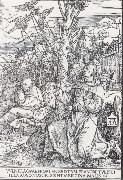 |
St.Francis Receiving the Stigmata |
mk168
218x144mm
|
| 29926 |
 |
St.James the Apostle |
mk67
Tempera on canvas
18 1/8x14 9/16in
Uffizi,Gallery
|
| 42290 |
 |
St.Jerome in his Cell |
mk168
Oil on wood
60x48cm
|
| 42254 |
 |
St.Jerome in his study |
mk168
192x134mm
|
| 42299 |
 |
St.Jerome in his study |
mk168
247x188mm
|
| 1055 |
 |
St.Jerome in the Wilderness |
1494
Fitzwilliam Museum, Cambridge |
| 42425 |
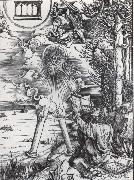 |
St.John Devouring the book |
mk168
391x284mm
|
| 42471 |
 |
St.John the Baptist |
mk168
Oil on wood
58x20cm
|
| 42426 |
 |
St.Michael Battling the Dragon |
mk168
394x283mm
|
| 42470 |
 |
St.Onuphrius |
mk168
Oil on linden wood
58x20cm
|
| 29927 |
 |
St.Philip the Apostle |
mk67
Tempera on canvas
17 11/16x15in
Uffizi,Gallery
|
| 42467 |
 |
Sts.Joseph and Joachim |
mk168
Oil on linden wood
94x54cm
|
| 42468 |
 |
Sts.Simeon and Lazarus |
mk168
97x55cm
Oil on linde wood
9 |
| 63656 |
 |
Studies of Self-Portrait |
Hand and Pillow 1493 Pen and ink on paper, 28 x 20 cm Metropolitan Museum of Art, New York This sketched self-portrait was on the reverse of the painted self-portrait of 1493, now in the Mus?e du Louvre, Paris. It could well have been an early study for the oil painting.Artist:D?RER, Albrecht Title: Studies of Self-Portrait, Hand and Pillow Painted in 1501-1550 , German - - graphics : study |
| 63671 |
 |
Study of a Drapery |
1508 Brush drawing on dark paper with white highlights, 257 x 192 mm Mus?e du Louvre, Paris Study for the Christ in the Coronation of the Virgin section of the Heller Altar.Artist:D?RER, Albrecht Title: Study of a Drapery Painted in 1501-1550 , German - - graphics : study |
| 63593 |
 |
Study of a Man Aged |
1521 Brush drawing on gray violet primed paper, 415 x 282 mm Graphische Sammlung Albertina, Vienna D?rer prepared the painting of St Jerome (Museu Nacional de Arte Antiga, Lisbon) in several sketches. His model was a 93 year-old man from Antwerp. In this naturalistic brush drawing, the old man is already leaning his head on his hand, but in contrast with the painting is engrossed in his studies. In a handwritten note above the picture D?rer informs us that: "The man was 93 years old and still healthy."Artist:D?RER, Albrecht Title: Study of a Man Aged 93 Painted in 1501-1550 , German - - graphics : study |
| 63683 |
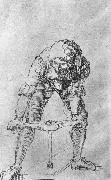 |
Study of a Man with a Drill |
1496 Pen and ink on paper, 251 x 151 mm Mus?e Bonnat, Bayonne This is a study for the lower right panel of The Seven Sorrows of the Virgin (Gem?ldegalerie, Dresden). The panel depicts the Nailing to the Cross, where a man in the centre is drilling a hole in the Cross.Artist:D?RER, Albrecht Title: Study of a Man with a Drill Painted in 1501-1550 , German - - graphics : study |
| 63660 |
 |
Study of an Apostle's Hands |
1508 Brush drawing on blue primed paper, 290 x 197 mm Graphische Sammlung Albertina, Vienna Several individual studies made for the destroyed altarpiece commissioned by the Frankfurt merchant and councilman Jakob Heller still survive. The so-called Praying Hands were a preliminary study for an apostle. Removed from their original context, they have been viewed as an autonomous work of art and have become enormously popular. In the 19th and 20th centuries in particular, numerous reproductions of the Praying Hands have graced the walls of middle-class homes as an embodiment and symbol of German piety.Artist:D?RER, Albrecht Title: Study of an Apostle's Hands (Praying Hands) Painted in 1501-1550 , German - - graphics : study |
| 63645 |
 |
Study of an Architect |
1506 Brush and ink heightened with white on paper, 386 x 262 mm Staatliche Museen, Berlin D?rer worked very hard on the Altarpiece of the Rose Garlands, and no less than 22 of his studies for the work have survived. These include a sketch of an architect holding a set square, probably Hieronymous of Augsburg. He is dressed in black at the far right of the painting, near the front. Hieronymous was then working on the reconstruction of the Fondaco dei Tedeschi, the Germans' trading house in Venice which had been destroyed by fire in 1505.Artist:D?RER, Albrecht Title: Study of an Architect Painted in 1501-1550 , German - - graphics : study |
| 63665 |
 |
Study of Drapery |
1508 Brush drawing on a dark ground with white highlight, 400 x 235 mm Staatliche Museen, Berlin This drawing, a study for the figure of St Paul in the Heller Altar, is a primary example of the monumental drapery of the middle period. The contrast with Gr?newald should be borne in mind: in D?rer, the light and shade are entirely subservient to the plastic form; in Gr?newald, they create a general, unseizable movement that extends beyond the surfaces and blends the figure into the background.Artist:D?RER, Albrecht Title: Study of Drapery Painted in 1501-1550 , German - - graphics : study |
| 63650 |
 |
Study of Hands |
1506 Pen and ink heightened with white on paper, 206 x 185 mm Blasius Collection, Braunschweig D?rer's painting Christ among the Doctors (1506, Thyssen-Bornemisza Collection, Madrid) was based on a number of careful studies, including this one of Christ's gesticulating fingers.Artist:D?RER, Albrecht Title: Study of Hands Painted in 1501-1550 , German - - graphics : study |
| 63674 |
 |
Study of the Christ Child |
1495 Pen drawing, 172 x 215 mm Mus?e du Louvre, Paris D?rer's pen drawing of a Christ Child is based on a design by the Florentine painter Lorenzo di Credi, which the latter made use of in several works, and it may have been used as a preliminary study for his Virgin and Child (Magnani Collection, Mamiano near Parma). Although the body posture and gestures differ, the types of faces of the two Infant Christs in the painting and drawing are comparable.Artist:D?RER, Albrecht Title: Study of the Christ Child Painted in 1501-1550 , German - - graphics : study |
| 63596 |
 |
Sudarium Displayed by Two Angels |
1513 Engraving, 102 x 140 mm Metropolitan Museum of Art, New York D?rer mentions this engraving in his diary of the journey to the Netherlands on two occasions, August 19 and August 20, 1520, when he gave copies away as presents. He refers to it as "Veronicam." It is one of the very few D?rer engravings in horizontal format. It is the crowning representation of the Passion series. The new face of Christ, created by D?rer, appears here in its purest form. The features of the Saviour bear an unmistakable resemblance to D?rer's own. Definitely heraldic in character, the angels are balanced with almost perfect symmetry, yet subtly differentiated in pose and gesture. The Holy Face fastens its eyes on the beholder with hypnotic intensity. The likeness of Christ served as the basis for a large woodcut sometimes attributed to Hans Sebald Beham.Artist:D?RER, Albrecht Title: Sudarium Displayed by Two Angels Painted in 1501-1550 , German - - graphics : religious |
| 93897 |
 |
Sylvan Men with Heraldic Shields |
1499(1499)
Medium oil on linden wood
Dimensions Height: 49.3 cm (19.4 in). Width: 15.9 cm (6.3 in).
cjr |
| 42350 |
 |
The Abduction on the Unicorn |
mk168
350x254mm
1516
|
| 63583 |
 |
The Adoration |
1524 Pen, 215 x 294 mm Graphische Sammlung Albertina, Vienna Perhaps this is a study for the introductory piece of the last, uncompleted, Passion woodcut series. The nobility of the composition is combined with a truly radiant beauty of line.Artist:D?RER, Albrecht Title: The Adoration of the Wise Man Painted in 1501-1550 , German - - graphics : study |
| 42480 |
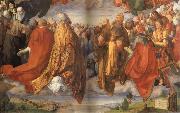 |
The Adoration of the Holy Trinity |
mk168
135x123cm
Oil on paplar
|
| 42481 |
 |
The Adoration of the Holy trinity |
mk168
135x123cm
Oil n poplar
|
| 63753 |
 |
The Adoration of the Holy Trinity |
1511 Oil on lindenwood, 135 x 123,4 cm Kunsthistorisches Museum, Vienna This work was commissioned by the Nuremberg metal trader Matth?us Landauer. Also known as the Landauer Altarpiece, it was ordered for the chapel of the Twelve-Brothers House, which he endowed for a dozen impoverished artisans. In the centre of the painted panel at the top is the Trinity. God the Father is shown as emperor, holding Christ on the Cross and surmounted by the dove of the Holy Ghost. Around the figure of God are two rings of angels. Below them, to the right, are Old Testament figures and, to the left, followers of Christ bearing palm branches. Nearer the base of the picture are the slightly larger figures of the living, led by the Pope (with a blue tiara) and the Emperor (with a golden crown). The grey-haired figure of Matth?us Landauer, the donor, is depicted on the left, being welcomed into the throng by the outstretched hand of a cardinal. The landscape at the bottom of the panel stretches into the far distance. A lone figure stands on the land - the artist, who has depicted the earthly community being reunited with the realm of heaven. His hand rests on a panel which is inscribed: `Albrecht D?rer of Nuremberg made this 1511 years after the Virgin.' D?rer also designed an ornate frame for the altarpiece. An early drawing for the frame and panel is dated 1508 and shows that they were a carefully designed ensemble. The frame still survives in the Germanisches Nationalmuseum, Nuremberg, although unfortunately it has long been separated from the painting. (The frame shown in the reproduction is an exact replica of the original.) Made of carved and painted wood, the top of the frame has a sculpted depiction of the Last Judgement, with God enthroned and surrounded by the kneeling figures of the Virgin and John the Baptist. An inscription on the base of the frame records: `Matth?us Landauer has finally completed the house of worship of the Twelve Bretheren including the donation of this panel. After Christ's birth, the year 1511.' D?rer's workshop also designed stained-glass windows for the Twelve-Brothers Chapel, but these were removed in 1810 and were destroyed in Berlin during the Second World War.Artist:D?RER, Albrecht Title: The Adoration of the Holy Trinity (Landauer Altar) Painted in 1501-1550 , German - - painting : religious |
| 29924 |
 |
The Adoration of the Magi |
mk67
Oil on panel
39x44 1/16in
Uffizi,Gallery
|
| 42459 |
 |
The Adoration of the magi |
mk168
Oil on fir wood
75.5x170cm
Basel
|
| 42469 |
 |
The Adoration of the Magi |
mk168
100x114cm
Oil on coniferouswood
|
| 86879 |
 |
The Adoration of the Magi |
Date 1504(1504)
Medium Oil on wood
Dimensions Height: 100 cm (39.4 in). Width: 114 cm (44.9 in).
cjr |
| 1049 |
 |
The Adoration of the Magi_z |
1504-05
Galleria degli Uffizi, Florence |
| 33514 |
 |
The Adoration of the Trinity |
mk86
1511
Oil tempera on wood
135x123cm
Vienna,Kunsthistorisches Museum
|
| 63754 |
 |
The Adoration of the Trinity |
1511 Oil on lindenwood Kunsthistorisches Museum, Vienna To the right is a figure, easily identifiable from his armor, as Landauer's son-in-law, Wilhelm Haller, a mercenary captain. In the lower part of the painting, almost to contrast the suspended scores of saints and men and women, D?rer offers us, from a slightly raised perspective, the vision of a landscape passage. This one, even more than the one in the Heller Altar, disappears into an infinite background, illuminated by a most gentle evening light that also shimmers against the clouds. In this deserted terrestrial kingdom, D?rer painted himself, the only human being. He is set apart toward the right margin, dressed as usual in a rich fur cloak, and indicative of an ancient styled tablet with the inscription: ALBERTVS DVRER NORICVS FACIEBAT ANNO A VIRGINIS PARTV[M] 1511.Artist:D?RER, Albrecht Title: The Adoration of the Trinity (detail) Painted in 1501-1550 , German - - painting : religious |
| 63755 |
 |
The Adoration of the Trinity |
1511 Oil on lindenwood Kunsthistorisches Museum, Vienna The landscape at the bottom of the panel stretches into the far distance.Artist:D?RER, Albrecht Title: The Adoration of the Trinity (detail) Painted in 1501-1550 , German - - painting : religious |
|
|
|
Prev 1 2 3 4 5 6 7 Next
|
|
| Albrecht Durer
|
| b.May 21, 1471, Imperial Free City of Nernberg [Germany]
d.April 6, 1528, Nernberg
Albrecht Durer (May 21, 1471 ?C April 6, 1528) was a German painter, printmaker and theorist from Nuremberg. His still-famous works include the Apocalypse woodcuts, Knight, Death, and the Devil (1513), Saint Jerome in his Study (1514) and Melencolia I (1514), which has been the subject of extensive analysis and interpretation. His watercolours mark him as one of the first European landscape artists, while his ambitious woodcuts revolutionized the potential of that medium. D??rer introduction of classical motifs into Northern art, through his knowledge of Italian artists and German humanists, have secured his reputation as one of the most important figures of the Northern Renaissance. This is reinforced by his theoretical treatise which involve principles of mathematics, perspective and ideal proportions.
His prints established his reputation across Europe when he was still in his twenties, and he has been conventionally regarded as the greatest artist of the Renaissance in Northern Europe ever since.
. Related Artists to Albrecht Durer : | Cornelis Van Leemputten | Charles Hazelwood Shannon | Worth Brehm | Domenico Zampieri | William Hodges | |

|
|